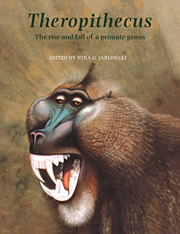
-
Select format
-
- Publisher:
- Cambridge University Press
- Publication date:
- 11 November 2009
- 04 March 1993
- ISBN:
- 9780511565540
- 9780521018494
- Dimensions:
- Weight & Pages:
- Dimensions:
- (246 x 189 mm)
- Weight & Pages:
- 0.982kg, 556 Pages
You may already have access via personal or institutional login
Book description
This unique volume provides a comprehensive and up-to-date examination of all aspects of the biology of the Old World monkey genus, Theropithecus, which evolved alongside our human ancestors. The authors explore the fossil history and evolution of the genus, its biogeography, comparative evolutionary biology and anatomy, and the behaviour and socioecology of the living and extinct representatives of the genus. The parallels between the evolution of Theropithecus and early hominids are discussed. There are also two chapters of particular significance which describe how an innovative and exciting approach to the modelling of the causes of species extinction can be used with great success. This highly multidisciplinary approach provides a rare and insightful account of the evolutionary biology of this fascinating and once highly successful group of primates. Theropithecus will be of interest to researchers in the fields of primatology, anthropology, palaeontology, and mammalian behaviour, physiology and anatomy.
Reviews
"...an impressive array of approaches to understanding this other group of late Neogene large African terrestrial primates." Gregory J. Retallack, Priscum
"...As a primate, theropiths are important for our evolution. This volume is a fine study of the genus, and it is highly recommended." New York Paleontological Society
"Nina Jablonski's book should introduce a wider audience to the geladas, and seve as an indispensible reference for those who work on the genus and anyone with an interest in the Plio-Pleistocene....I feel that this is a very valuable book and that the editor, authors and publisher have accomplished a great serice in producing this volume." Journal of Human Evolution
"It is a tour de force. The layout, typesetting, the quality of the photographs, and even the jacket illustration are first rate. The contributors hail from eight different countries and are all experts in their respective fields. But its content and organization are where this volume truly excels. The editor, Nina Jablonski, has done a superb job, uniting the topics of the volume into four main sections....The topical coverage of Theropithecus in this fine volume is nearly perfect....[T]he volume will remain an important source of information about this unusual primate well into the twenty-first century. This is a volume that every primatologist, primate paleontologist and all sentient paleoanthropologists should have on their shelves....Nina Jablonski deserves thanks from all of us for assembling this wonderful work." Russell L. Ciochon, Evolutionary Anthropology
Contents
Metrics
Altmetric attention score
Full text views
Full text views help Loading metrics...
Loading metrics...
* Views captured on Cambridge Core between #date#. This data will be updated every 24 hours.
Usage data cannot currently be displayed.
Accessibility standard: Unknown
Why this information is here
This section outlines the accessibility features of this content - including support for screen readers, full keyboard navigation and high-contrast display options. This may not be relevant for you.
Accessibility Information
Accessibility compliance for the PDF of this book is currently unknown and may be updated in the future.


